4-4-2 Formation – The Ultimate Coaching Guide
Over the past 10 to 15 years, modern teams have transitioned away from using the 4-4-2 formation, which had dominated the game for several decades.
The primary reason for this transition is the tactical shift in how teams set up their midfield.
Modern teams tend to use more specialized players in their midfield, rather than play with two box-to-box midfielders.
Setting out with a center defensive midfielder (CDM) and a number 10 is the preferred strategy among coaches.
These types of players operate between the lines, which suits the possession-based philosophies that most of today’s teams abide by.
While 4-4-2 is no longer the most dominant formation, it’s the original shape of modern soccer and it’s still relevant.
Many teams still rely on it and with the right players in place, it’s extremely effective.
Below, I break down the 4-4-2 formation in-depth and explain its strengths and weaknesses, ensuring you can get the most out of your team in this shape.
What is a 4-4-2 Formation?
The 4-4-2 formation is soccer’s perennial formation and has been a mainstay in the game at all levels for decades.
It’s much loved by coaches and players due to its balance and simplicity.
In a traditional 4-4-2, the center midfielders (CMs) work as a unit.
When one goes forward, the other drops back, and vice-versa.
Well-rounded, box-to-box midfielders, like Jude Bellingham or Martin Odegaard, are perfect for the midfield due to their ability to attack and defend.
The standard flat-back four offers defensive solidity and gives the fullbacks license to get forward.
Right and left midfielders are deployed mainly for their attacking prowess but must also track back and defend wide areas.
With two center forwards, this formation allows you to play direct, swing in crosses from the wings, or build patiently through the lines.
Tactics evolve and teams change, but a 4-4-2 formation will always be there to fall back on.
A safe, stable option for any team.
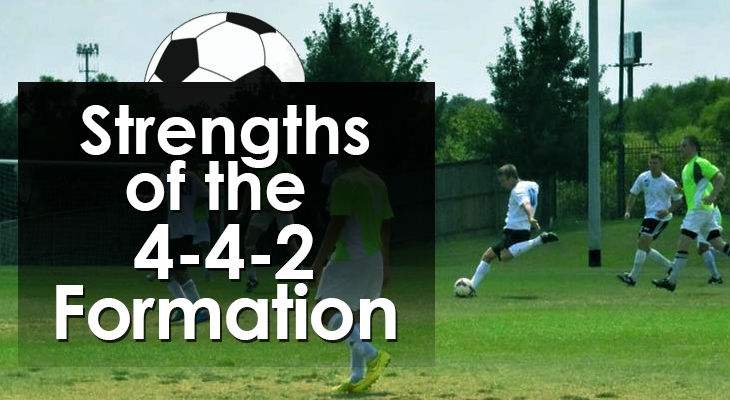
4-4-2 Formation Strengths
#1. Simplicity
As one of the most popular formations for generations, the vast majority of players are familiar with the 4-4-2 and the individual player roles.
The setup is straightforward and there aren’t any “specialized” or nuanced positions like a deep-lying playmaker or wingback.
With two banks of four and a double-striker partnership, the formation is symmetrical, allowing players to fill their positions naturally.
From a coaching perspective, you can build a high-functioning team in a 4-4-2 very quickly without the need for complex positional training and tape studies.
#2. Dual Strikers
Playing with two strikers is a rarity in the modern game, with most teams opting for a sole center forward supported by a deeper number 10.
However, dual forwards are a defender’s nightmare.
Both center backs (CBs) are constantly occupied and are frequently put in 1v1 situations against skillful attackers.
Slick center forwards play off one another, linking the play and making alternative runs.
Moreover, the extra presence in the box makes the team much harder to defend against.
#3. Defensive Cover Across the Field
With two banks of four in the midfield and defense, the 4-4-2 formation ensures there’s defensive cover in all positions.
This allows the team to absorb pressure and press the opposition in certain areas of the field.
Players are rarely left isolated, making weak points hard to detect for opponents.
An overlooked benefit of having two strikers is the ability to press from the front.
The double attackers not only make it difficult for the center backs to pass the ball, but they can also target the CDM or playmaker in midfield, limiting their effectiveness.
#4. Well-Balanced Shape
As mentioned the 4-4-2 formation is extremely well-balanced with no clear weak points.
In this shape, your team can attack and defend in numbers with relative safety.
If the center midfielders begin to get overrun, the team can defend with more compactness by pulling the wingers into the center of the field and forming a mid-block.
This setup facilitates all types of strategies, including attacking, defensive, wide, central, or counter-based systems.
#5. Excellent Shape for Counterattacks
If you’re a Premier League fan, you may remember times throughout the 2000s when virtually every team played in a 4-4-2 formation.
The main reason for this was that at the time, counterattacking was seen as the most effective strategy.
Due to the spacing of the 4-4-2 formation, teams can drop back and soak in pressure then spring quickly into rapid counterattacks.
Sir Alex Ferguson’s Manchester United are perhaps the best example of a deadly counterattacking team in a 4-4-2.
They would invite opponents to come at them, but with two strikers up top at all times, they were always poised to explode on the counter.
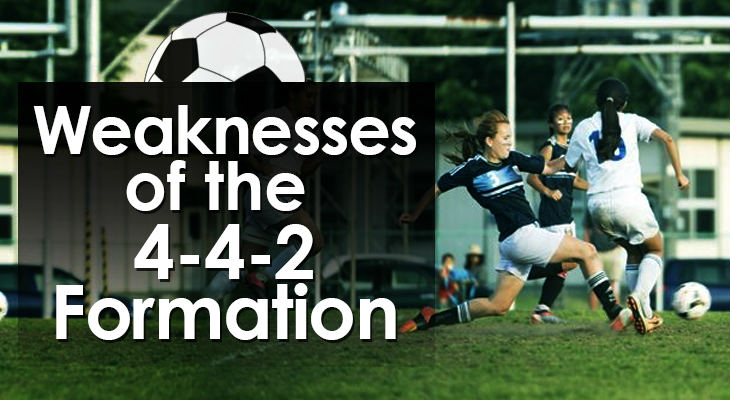
4-4-2 Formation Weaknesses
#1. Midfield Can Get Outnumbered
With only two center midfielders, your team may get outnumbered in central areas.
Since most modern coaches opt for a midfield three, this can be a major concern.
While other players, like a striker or winger, can drop in to help out, relying on them to do this consistently pulls the team out of shape.
#2. Space Between the Lines
The 4-4-2 formation sets up with three distinct lines: defenders, midfielders, and forwards.
This often leads to significant space between the three banks.
Opposition players who occupy the half spaces, like the CDM or number 10, can exploit this weakness and wreak havoc on your defense.
Against a strong possession-based side, your midfield may be passed through quite easily.
#3. Requires Disciplined Wingers
Although their main role is to attack, the wingers in a 4-4-2 must track back and help out their fullbacks.
As skillful flair players, a lot of wingers don’t have the discipline to fulfill their defensive duties consistently.
This puts a lot of pressure on the fullbacks and makes your team susceptible to deep crosses to the back post.
#4. Physically Demanding
Although the spacing of a 4-4-2 has a lot of upsides, it also means your players are required to put in a tough shift in each game.
Your team must be very fit and capable of meeting the physical demands.
In particular, the center midfielders cover a lot of ground as they work from box to box in the central channel.
#5. Not Suited to Possession-Based Tactics
As I mentioned, the 4-4-2 formation is best suited to counterattacking teams that aren’t looking to dominate possession.
When facing three-player midfields, there are very few gaps available to keep a hold of the ball.
If you want your team to outplay your opponents in the middle of the field and keep possession for long periods, this may not be the formation for you.
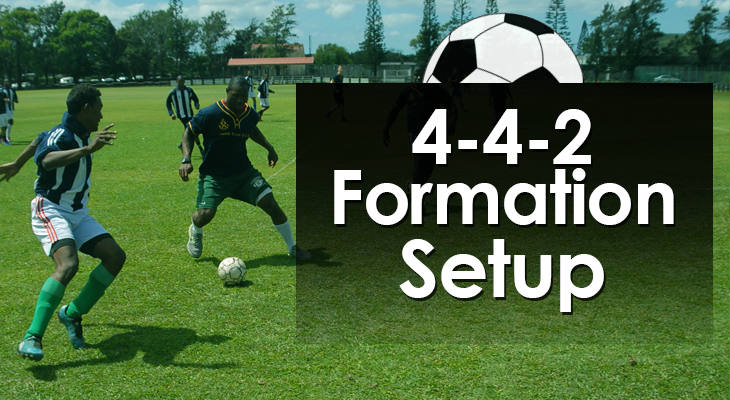
How to Play the 4-4-2 Formation
In addition to knowing a formation’s strengths and weaknesses, you must also learn how it functions.
Fortunately, the 4-4-2 formation is relatively straightforward and your team should take to it seamlessly.
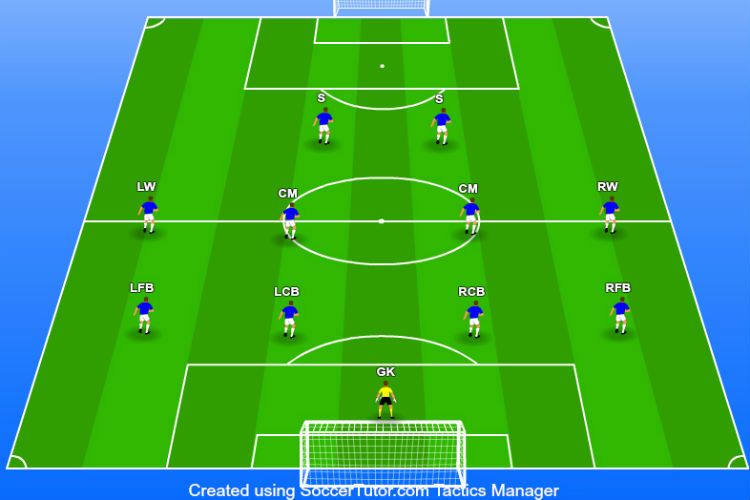
4-4-2 Formation Setup
The 4-4-2 formation has a relatively simple setup with three main units:
Four-player backline with two center backs and two fullbacks;
Four-player midfield with two center midfielders and two wide midfielders;
Dual strikers, leading the offensive line.
Attacking and defending should be fluid as each unit must work together to minimize gaps between the lines.
Here’s a detailed look at how to play the 4-4-2 formation.
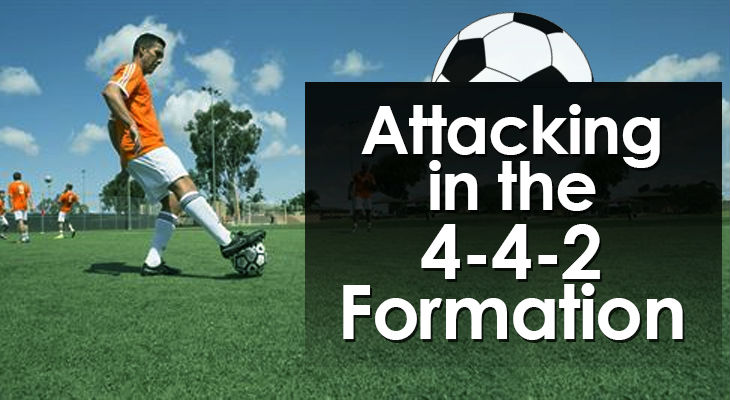
Attacking in the 4-4-2 Formation
With options out wide and through the middle, coaches are spoilt for choice when it comes to attacking options.
That said, it’s important to play to the strengths of the formation.
Unless your opponent goes toe to toe with you in a similar shape, it’s generally not a good idea to play overly expansive in a 4-4-2.
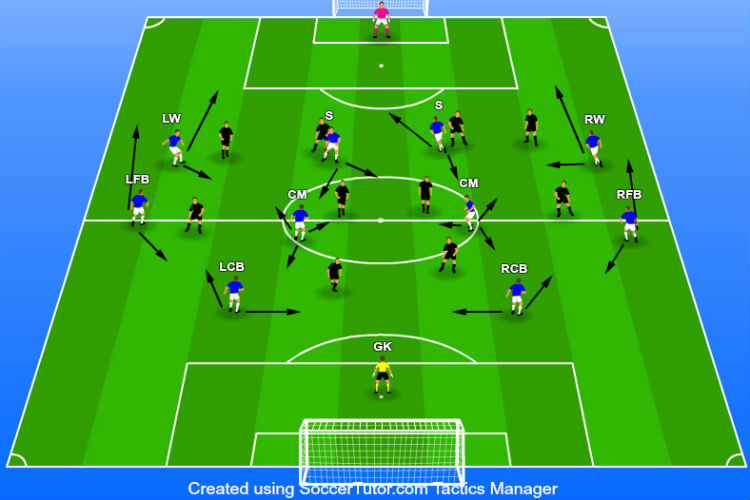
1. Move the Ball Quickly and Switch the Play
As discussed, the midfield can get outnumbered against a three-player midfield.
Therefore, when in possession, your team should be prepared to pass the ball quickly and use the width by switching the play from left to right.
This will reduce the risk of midfield congestion and help stretch a compact opponent.
Your fullbacks and wingers should work together, using one-twos and overlaps to get into good crossing positions out wide.
With two strikers to aim for, chance creation from the wing is an excellent pathway to success.
2. Target the Dual Strikers
The biggest attacking threat in a 4-4-2 formation is the dual-striker partnership.
As a coach, you should instruct your team to get the ball to your forwards as much as possible.
Having an extra attacker means the strikers find themselves in 1v1 situations quite often.
This not only makes chance creation easier, but it also opens up spaces for other players to run into.
Midfielders and wingers can time their runs into the box when strikers pull the center backs out of position.
3. Play on the Counter
At its core, the 4-4-2 is a counterattacking formation.
Therefore, you should treat it as such.
Ensure your team stays positionally disciplined and waits for opportunities to spring counters.
It’s generally a good idea to practice sequences for fast breaks, especially from set plays, like corner kicks.
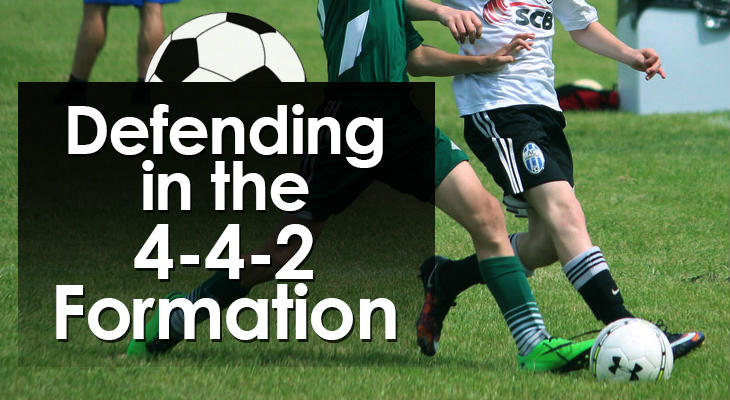
Defending in the 4-4-2 Formation
As a counter-based formation, there are three important tactics for making the 4-4-2 as solid as possible.
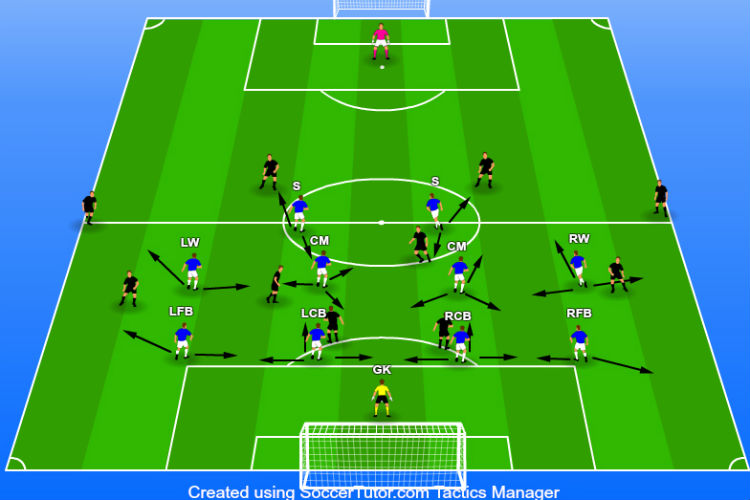
1. Stay Compact
The most effective defensive tactic in this shape is to stay compact as a team, meaning there is minimal space between the backline, the midfield, and the strikers.
With tight banks of players across the field, you limit the space between the lines, making it difficult for opponents to penetrate.
Once they begin to commit players forward, your team is ready to spring counterattacks.
2. Tuck in Out of Possession
Against popular formations like 4-3-3 or 4-1-2-1, the 4-4-2 tends to be open between the lines.
And, as discussed, you may give up the possession battle in this shape.
So, when your team is out of possession, the wingers should tuck in centrally and the strikers should drop back to plug any gaps.
Closing the open spaces also helps your players to conserve energy as they’re not sprinting constantly to cover large distances.
3. Remain Positionally Disciplined
Positional discipline is key to launching devastating counterattacks.
If your wingers get drawn into central areas and your strikers expend energy chasing players into their own half, they won’t be in position to threaten on the break.
While wingers and strikers have defensive duties, they must also trust their teammates to do their jobs.
As soon as possession is overturned, the most advanced striker should call for the ball while your wingers should hit the flanks looking to take advantage of the open space.
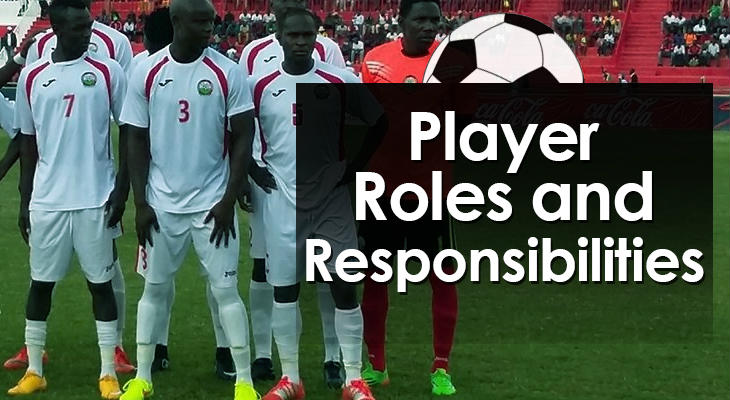
Individual Position Responsibilities
Goalkeeper
A ball-playing, sweeper keeper is a significant advantage in most modern teams.
However, since teams in a 4-4-2 tend to drop a little deeper, this type of goalie isn’t a must.
If you plan to soak up pressure and invite teams to shoot from distance, you’ll need a ‘keeper with safe hands and a commanding presence in the box.
Long-distance distribution skills are more important than ball-playing skills as the goalkeeper is likely to lead several counterattacks.
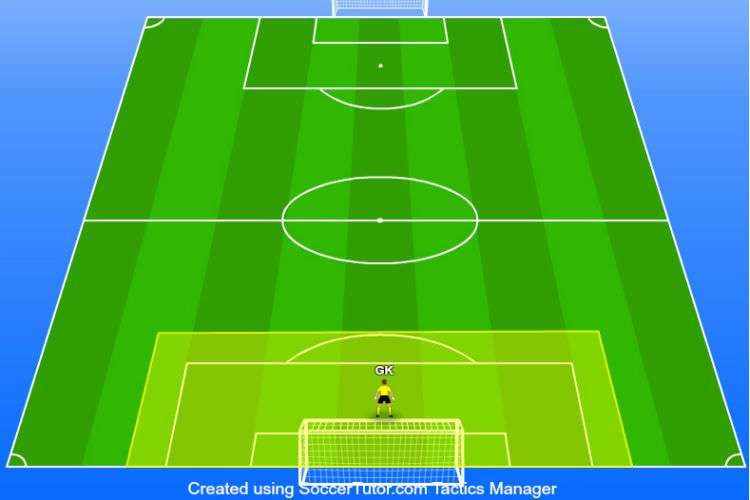
Center Backs
The center backs are the defensive backbone of any side and a solid pairing is essential for a good 4-4-2 team.
Sir Alex Ferguson, Manchester United’s legendary manager was known to build his teams around a great CB duo.
So, be sure to get your best defenders in the heart of your backline.
These two players should be physically imposing and capable of withstanding waves of attacks.
Shot blocking, heading, and tackling are your center backs’ bread and butter.
Positioning and soccer intelligence are essential skills for anticipating attacks and snuffing out any threats that come their way.
Ideally, the center backs will also be comfortable on the ball, though the priority of course is to defend the goal.
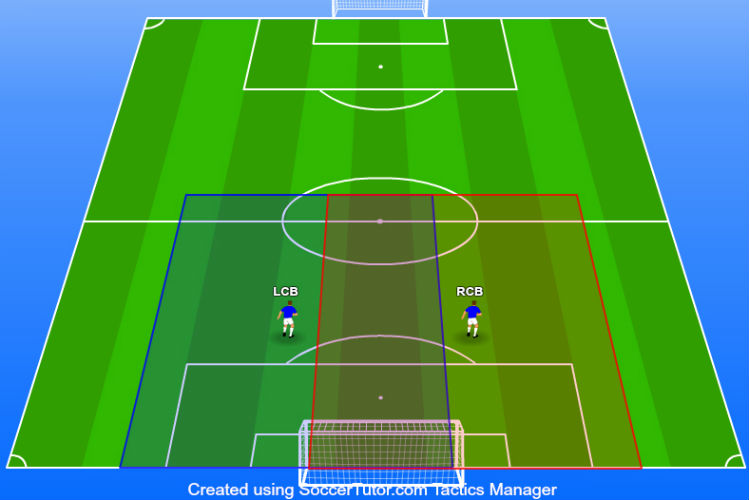
Fullbacks
In the modern game, the role of the fullback is becoming increasingly important.
While in the past they were almost solely required to defend, they are now expected to:
Bombard up and down the wing
Overlap and underlap with the wingers
Whip in dangerous crosses
Track back
Make big tackles.
Needless to say, they need to be very fit and quick.
Defensively, they must win their individual battles against opposition wingers, defend the wide areas with their lives, and cover the back post.
Although they’re not expected to score many goals, modern fullbacks cannot be offensive passengers.
They need to be able to add quality on the wings, whether they’re linking up with a winger or putting a cross on a striker’s head.
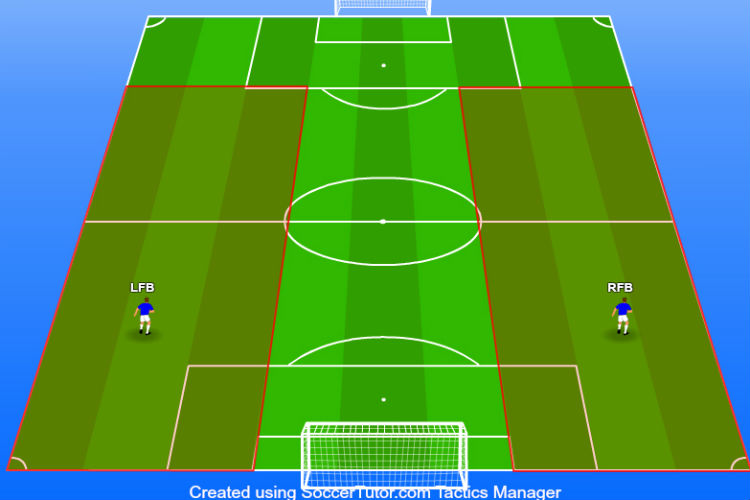
Center Midfielders
The center midfield pairing in a 4-4-2 formation generally consists of two box-to-box style players.
It’s up to them to dictate the pace of the game, exert control, and dominate the opposition’s midfield, which can be a challenge if they’re outnumbered.
A key responsibility of the CMs is to ensure there isn’t a lot of space between them and their backline and forward line.
Otherwise, their opponents can find pockets of space between the lines to create dangerous attacks.
The central midfield pairing must be extremely fit and mobile as they’re required to cover large distances in every game (more than any other player).
In addition, CMs need to be technically sound and capable of initiating attacks with line-breaking passes.
Above all, a CM should have excellent in-game intelligence and quick decision-making skills as much of their work occurs in the business area of the field.
As the saying goes, games are won and lost in midfield.
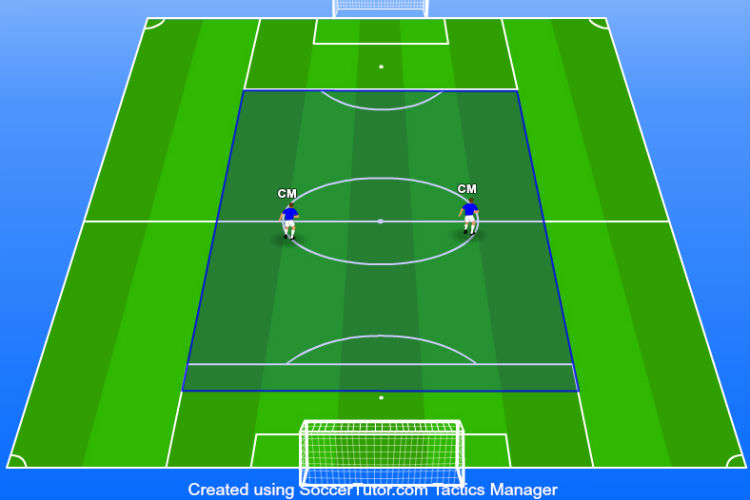
Right and Left Midfielders (Wingers)
In a 4-4-2 formation, a lot of the creative responsibility falls on the wingers.
They rely on their individual skill, pace, and technique to beat their marker and create goalscoring opportunities for the strikers.
When playing on their natural side, wingers tend to attack the space along the sidelines and whip n crosses from wide areas.
Inverted wingers, which are very common in today’s game, enjoy cutting inside to join central attacks or shoot from the edge of the box.
Tracking back and marking marauding fullbacks are important parts of their job.
In some instances, wingers should also tuck in centrally to help out their CMs.
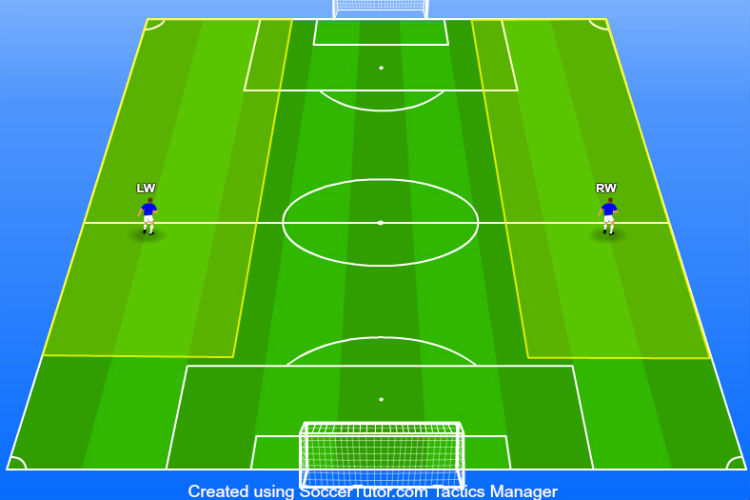
Dual Strikers
As the team’s main offensive threat, the dual strikers are heavily relied upon to put the ball in the back of the net.
Your strikers must get to know each other’s tendencies, movements, and preferences.
That way, they can work in tandem to create and execute chances.
It can greatly benefit the team both strikers have differing skill sets.
One target man and one center forward who likes the ball to feet can be a deadly combination, giving a dynamic edge to your team.
Movement patterns are also key for an effective attacking duo.
Although strikers need to be selfish, they also have to be good teammates.
Strikers who make dummy runs or drift away from goal can drag center backs out of position, leaving room for the other forward to move into.
As long as both strikers or on the same wavelength, they’ll both rack up a lot of goals throughout the season.
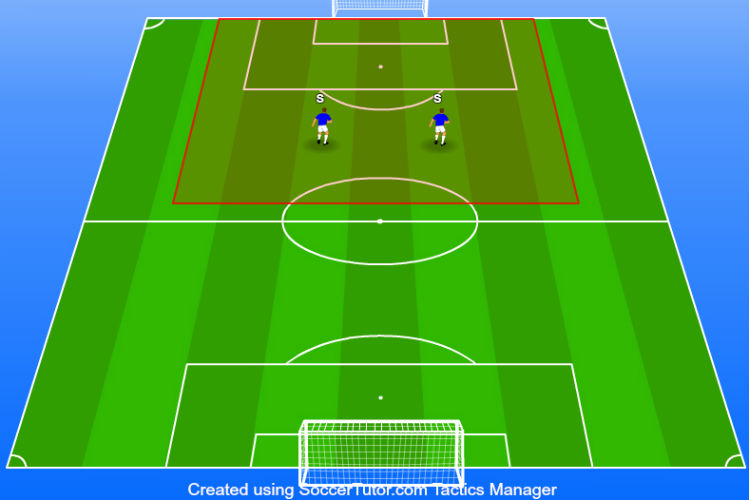
How to Beat a 4-4-2 Formation
The 4-4-2 formation threatens in so many areas and with two strikers to think about at all times, you’re never fully at ease.
But despite how dangerous a counterattacking formation it is, there are tried and tested ways to beat the 4-4-2.
If you’re preparing to face a team that uses this shape, here are three keys to victory.
1. Overload the Midfield
With three center midfielders, your team can break through the middle block with consistency.
When setting up against a midfield two, opt for a trio and instruct your players to play around them using passing triangles.
The extra player not only makes it easier to create attacks through the middle, but it also prevents the opposition CMs from setting up meaningful offense of their own.
2. Deploy Players in the Half Spaces
Another obvious weakness of the 4-4-2 formation is the gaps between the defense and midfield, and the strikers and the midfield.
Deploy center attacking midfielders (CAM) and defensive midfielders to occupy these spaces.
You’ll find that your team can break through the lines at will, forcing your opponents to lose their shape and step out of position.
3. Be Patient and Don’t Overcommit
While you may understand the shortcomings of a 4-4-2, they’re not always obvious at the beginning of the game when players have fresh legs.
Against a tough team, it will take time to break them down.
However, with patience and consistent pressure, you can wear down a team in a 4-4-2, eventually opening gaps.
Instruct your team to keep the ball, break down the midfield, and wait for opportunities to get in behind.
4-4-2 Formation Variations
4-4-2 Diamond
While many teams play a flat four across the midfield, others prefer to play a diamond shape instead.
The only difference is how the midfielders are set out.
In a diamond, one midfielder sits back, playing as a CDM, while the other takes on a more attacking role as a CAM.
With the wingers on either side, the midfield now replicates a diamond.
Some coaches instruct their wingers to play more narrowly, limiting the space between the CDM and CAM.
The diamond shape helps your team cover the half-spaces, which are an obvious weakness of a traditional, flat 4-4-2.
However, the extra presence in the half spaces comes at the expense of width.
The CDM and CAM can also become isolated, hampering the fluidity of your build-up play.
That said, if you have top-level players in these midfield roles, the diamond can be devastating.
Conclusion
While past its heyday, the 4-4-2 formation still has a lot to offer the right team.
There is a reason that it is still widely used.
If your players are well-drilled, know their roles, and understand how to work as a team, you’ll enjoy success in this shape.
With speedy attackers at your disposal, your team will be a major threat on the break.

